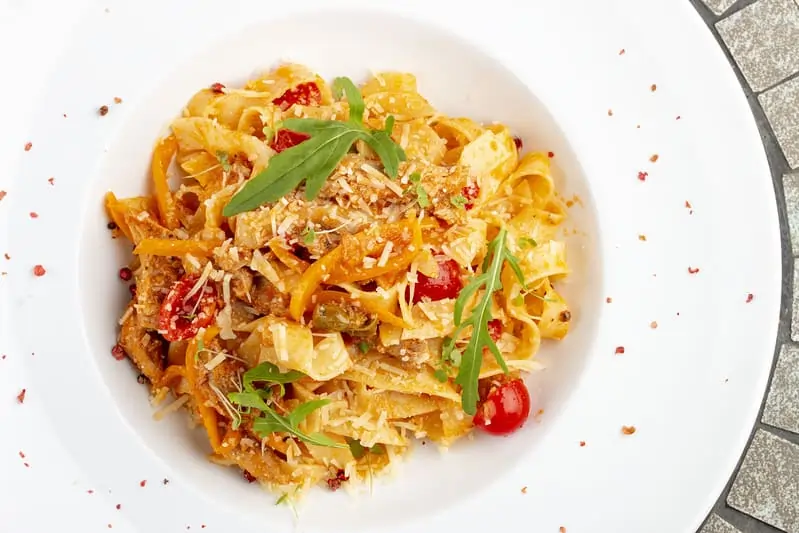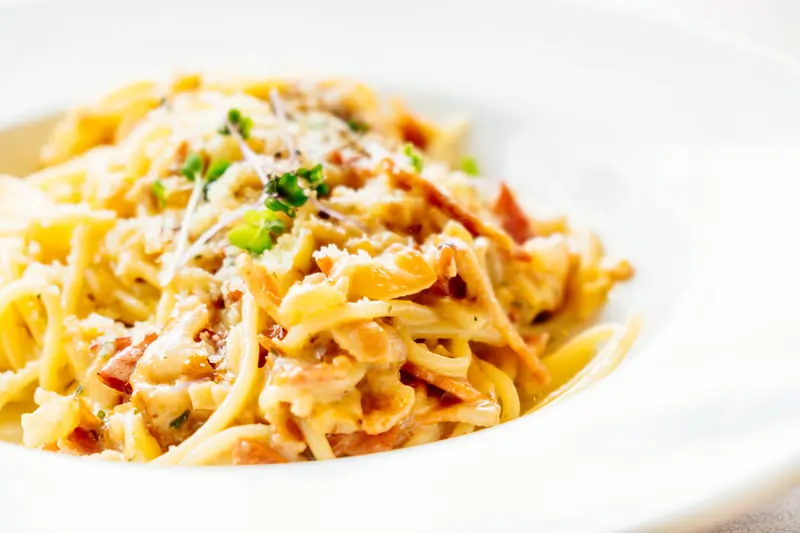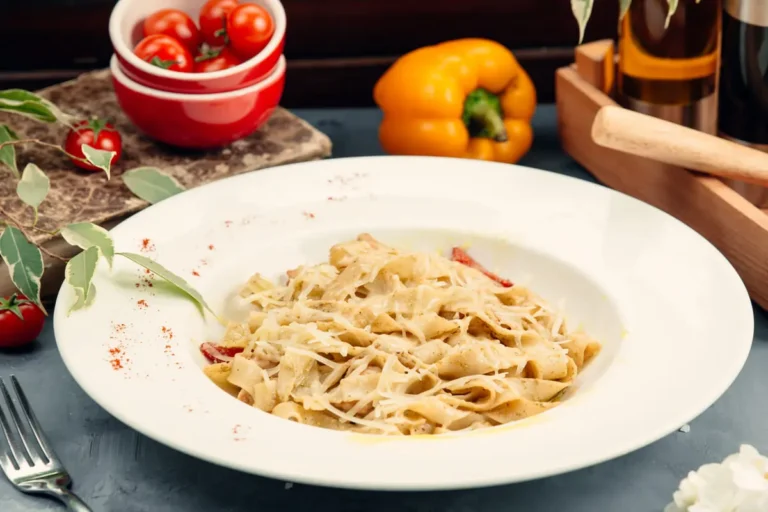Fettuccine carbonara is one of the most beloved Italian pasta dishes, offering a creamy, luxurious flavor profile with minimal ingredients. This classic Roman recipe features silky eggs, sharp Pecorino Romano, smoky guanciale, and a generous pinch of black pepper. Whether for a cozy dinner or an elegant occasion, it’s sure to impress.
For inspiration on adapting traditional recipes, explore Matcha Tiramisu: A Perfect Fusion of Japanese and Italian Flavors.What is Fettuccine Carbonara?
Fettuccine carbonara pairs the flat, ribbon-like pasta with the rich carbonara sauce for a dish that is indulgent yet straightforward. Its origins trace back to Rome, where simplicity and quality ingredients reign supreme. Unlike American adaptations, traditional carbonara avoids cream, relying on eggs and Pecorino Romano for its creamy consistency.
For more Italian classics, check out Easy Moist Banana Bread Recipe, another comfort food staple with a twist.
Ingredients for Fettuccine Carbonara

Creating an authentic and flavorful fettuccine carbonara requires just a few high-quality ingredients. This simple yet elegant dish highlights the rich flavors of Pecorino Romano cheese, crispy guanciale, and silky egg-based sauce. Below is everything you need for four servings:
For the Sauce
- 4 Large Eggs (Room Temperature): The base of the creamy sauce. Room-temperature eggs blend more easily with the cheese and pasta, creating a smoother texture.
- 100g Pecorino Romano Cheese (Finely Grated): This sharp, salty cheese is key to authentic carbonara. Grating it finely ensures it melts seamlessly into the sauce.
- Freshly Cracked Black Pepper (to taste): Adds a warm, aromatic kick that balances the richness of the sauce. Use freshly cracked pepper for maximum flavor.
For the Pasta and Protein
- 400g Fettuccine Pasta: While traditional carbonara uses spaghetti, fettuccine’s wide, flat shape holds the sauce beautifully.
- 150g Guanciale (or Pancetta or Thick-Cut Bacon): Guanciale is the traditional choice, providing a rich, porky flavor. Pancetta or bacon can be used as substitutes but may have a slightly different texture.
- Salt (for pasta water): Salting the water is essential to enhance the flavor of the pasta itself.
Step-by-Step Recipe for Fettuccine Carbonara

Follow these detailed steps to prepare a perfectly creamy and flavorful fettuccine carbonara:
1. Prepare the Ingredients
Proper preparation ensures smooth cooking:
- Dice 150g of guanciale (or your substitute of choice) into small cubes for even cooking.
- Grate 100g of Pecorino Romano cheese as finely as possible to ensure it melts effortlessly into the sauce.
- Beat the 4 large eggs lightly in a mixing bowl. Add the grated Pecorino and a generous amount of freshly cracked black pepper. Whisk until you have a cohesive, thick mixture.
2. Cook the Pasta
Perfectly cooked pasta is the foundation of this dish:
- Bring a large pot of salted water to a rolling boil.
- Cook 400g of fettuccine until al dente, following package instructions.
- Before draining the pasta, reserve 1 cup of pasta water. This starchy water will help emulsify the sauce and achieve its signature creaminess.
3. Render the Guanciale
The rendered fat from guanciale provides the primary flavor base for the sauce:
- Heat a large skillet over medium heat.
- Add the diced guanciale and cook slowly, allowing the fat to render out while the meat becomes golden and crispy.
- Once crispy, remove the skillet from the heat but leave the rendered fat in the pan. This fat will coat the pasta and enhance the flavor of the dish.
For more insights on achieving perfect textures in your recipes, explore Why Is My Banana Bread Not Moist? Troubleshooting Common Baking Issues.
4. Temper the Egg Mixture
Tempering the eggs ensures a silky sauce without scrambling:
- Slowly whisk in 2–3 tablespoons of reserved pasta water to the egg mixture. This gradual addition raises the temperature of the eggs gently, preventing curdling when combined with the hot pasta.
- The mixture should remain smooth and creamy, resembling a custard-like consistency.
5. Combine Pasta and Sauce
The final step brings everything together in a harmonious blend of flavors:
- Add the cooked fettuccine to the skillet with the rendered guanciale fat. Toss the pasta to coat it evenly with the fat, infusing it with flavor.
- Pour the tempered egg mixture over the hot pasta while tossing quickly to distribute the sauce evenly. The residual heat from the pasta will cook the eggs gently, creating a glossy, creamy sauce. If needed, add a splash of the reserved pasta water to adjust the consistency.
Final Garnish
- Sprinkle additional Pecorino Romano cheese and freshly cracked black pepper over the plated pasta for extra flavor and visual appeal.
Pro Tips for Success
- Use room-temperature eggs to ensure smooth blending with the cheese and hot pasta.
- Avoid overheating the sauce during mixing, as it can scramble the eggs. Toss quickly and continuously for best results.
- Adjust the seasoning at the end, as guanciale and Pecorino are naturally salty.
For more ideas on incorporating rich and creamy textures into classic recipes, check out this Matcha Tiramisu Guide.
Final Thoughts
Fettuccine carbonara is a timeless dish that relies on quality ingredients and simple techniques to achieve its luxurious flavor. By following these detailed steps, you’ll master a creamy, indulgent pasta that’s perfect for a cozy dinner or an elegant occasion. Enjoy the art of carbonara!
Tips for the Perfect Carbonara
Mastering carbonara requires attention to detail and a few essential techniques. Here’s how to ensure your dish turns out perfectly creamy, flavorful, and authentic every time:
1. Use High-Quality Ingredients
The simplicity of carbonara means each ingredient plays a significant role in the overall flavor:
- Opt for authentic guanciale for its rich, porky flavor and tender texture. While pancetta or bacon are acceptable substitutes, guanciale offers the most traditional and flavorful result.
- Choose Pecorino Romano cheese, which provides the sharp, salty taste essential to balancing the dish. Grate it finely to ensure it incorporates smoothly into the sauce.
- Use fresh, high-quality eggs for a creamy texture and bright yellow color.
2. Avoid High Heat
One of the most common mistakes in carbonara is scrambling the eggs by exposing them to excessive heat:
- Cook off the heat: Once the pasta is combined with the guanciale and rendered fat, remove the skillet from direct heat before adding the egg mixture. The residual heat from the pasta is enough to cook the eggs gently, creating a glossy sauce.
- Whisk the eggs with reserved pasta water to temper them before combining with the pasta. This step prevents curdling and ensures a silky consistency.
3. Perfect the Balance
Achieving a harmonious blend of flavors is key to a standout carbonara:
- Adjust the amount of Pecorino Romano to suit your preference for saltiness and cheesiness.
- Use freshly cracked black pepper for its aromatic heat and adjust to taste. A generous amount complements the richness of the sauce while adding a subtle spice.
Creative Variations
For those looking to experiment with carbonara, these creative twists offer new flavors while maintaining the essence of the dish:
1. Vegetarian Carbonara
Replace guanciale with smoked mushrooms or plant-based bacon for a vegetarian-friendly version that still delivers on flavor. The smoky element adds depth, while the creamy egg-based sauce remains intact.
2. Seafood Carbonara
Introduce sautéed prawns or scallops for a luxurious twist. The seafood’s natural sweetness pairs beautifully with the creamy sauce and Pecorino cheese, making it an indulgent option for special occasions.
3. Creamy Carbonara
Although non-traditional, a small splash of heavy cream can be added to the egg mixture for extra richness. This variation is particularly appealing to those who enjoy a thicker, creamier sauce.
Final Tips
- Ensure the pasta is al dente, as this texture helps the sauce cling beautifully to each strand.
- Reserve pasta water liberally—it’s the secret ingredient that emulsifies the sauce and achieves the perfect consistency.
- Serve immediately for the best texture and flavor, as carbonara is at its peak when freshly prepared.
For more adaptable and innovative recipes, check out Banana Bread Cookies: The Perfect Fusion of Two Desserts
FAQs About Fettuccine Carbonara
1. Is cream traditional in carbonara sauce?
No, traditional carbonara relies solely on eggs, Pecorino Romano, and pasta water to create its creamy consistency. For a deeper dive into classic Italian dishes, explore Barilla Lasagna Recipe: Classic, Easy, and Delicious.
2. Can I use Parmesan instead of Pecorino Romano?
Yes, Parmesan can be a substitute, though Pecorino Romano provides a saltier, more authentic flavor. If you’re interested in other ways to adapt recipes, read Brown Butter Banana Bread: A Delicious Twist on a Classic Favorite.
3. How do you prevent scrambled eggs in carbonara?
Tempering the eggs with pasta water and mixing off the heat is key to achieving a smooth sauce. For more troubleshooting tips, check out Why Is My Banana Bread Not Moist? Troubleshooting Common Baking Issues.
4. What pasta shapes work best for carbonara?
While fettuccine is excellent, spaghetti, bucatini, or rigatoni also pair well with carbonara sauce. If you enjoy exploring different pasta dishes, visit Barilla Lasagna: A Comprehensive Review.
5. Can carbonara be made vegetarian?
Yes, you can substitute guanciale with smoked mushrooms or plant-based bacon for a vegetarian twist. For another creative vegetarian recipe, try Banana Bread Cookies: The Perfect Fusion of Two Desserts.
Serving Suggestions
Fettuccine carbonara pairs beautifully with:
- Salads: Caesar salad or arugula with lemon vinaigrette. Explore pairing ideas like those in The Ultimate Guide to Making 5-Ingredient Banana Bread.
- Vegetables: Garlic-roasted broccoli or grilled asparagus for a balanced meal.
- Bread: Warm focaccia or garlic knots. For more baking inspiration, check out Simple and Delicious 4-Ingredient Banana Bread.
Conclusion
Fettuccine carbonara exemplifies the beauty of simple ingredients combined to create a flavorful, satisfying dish. Whether you adhere to the traditional recipe or experiment with creative variations, this pasta remains a favorite among Italian cuisine enthusiasts. Serve it with pride for any occasion, knowing you’ve mastered an iconic dish.

